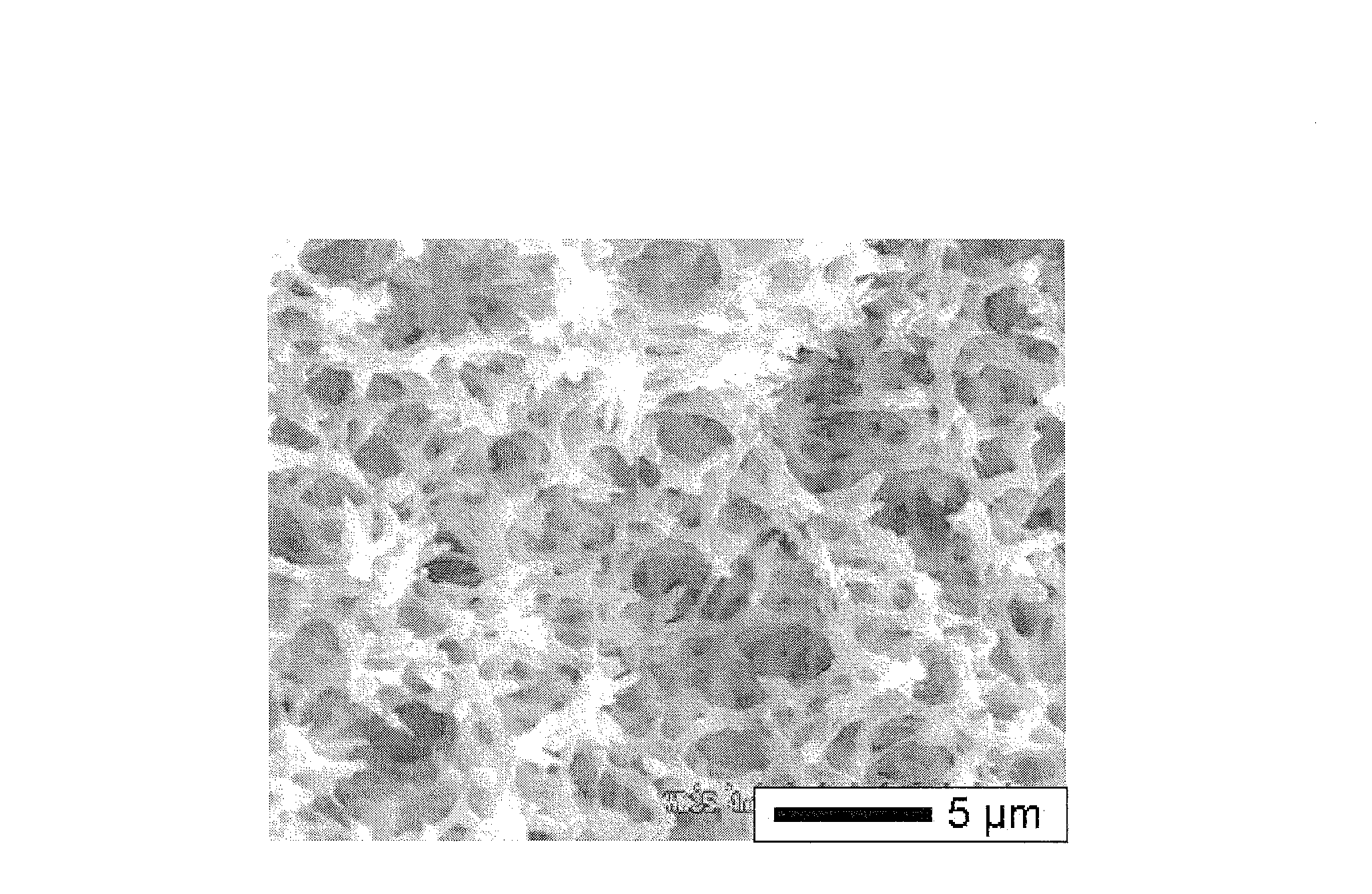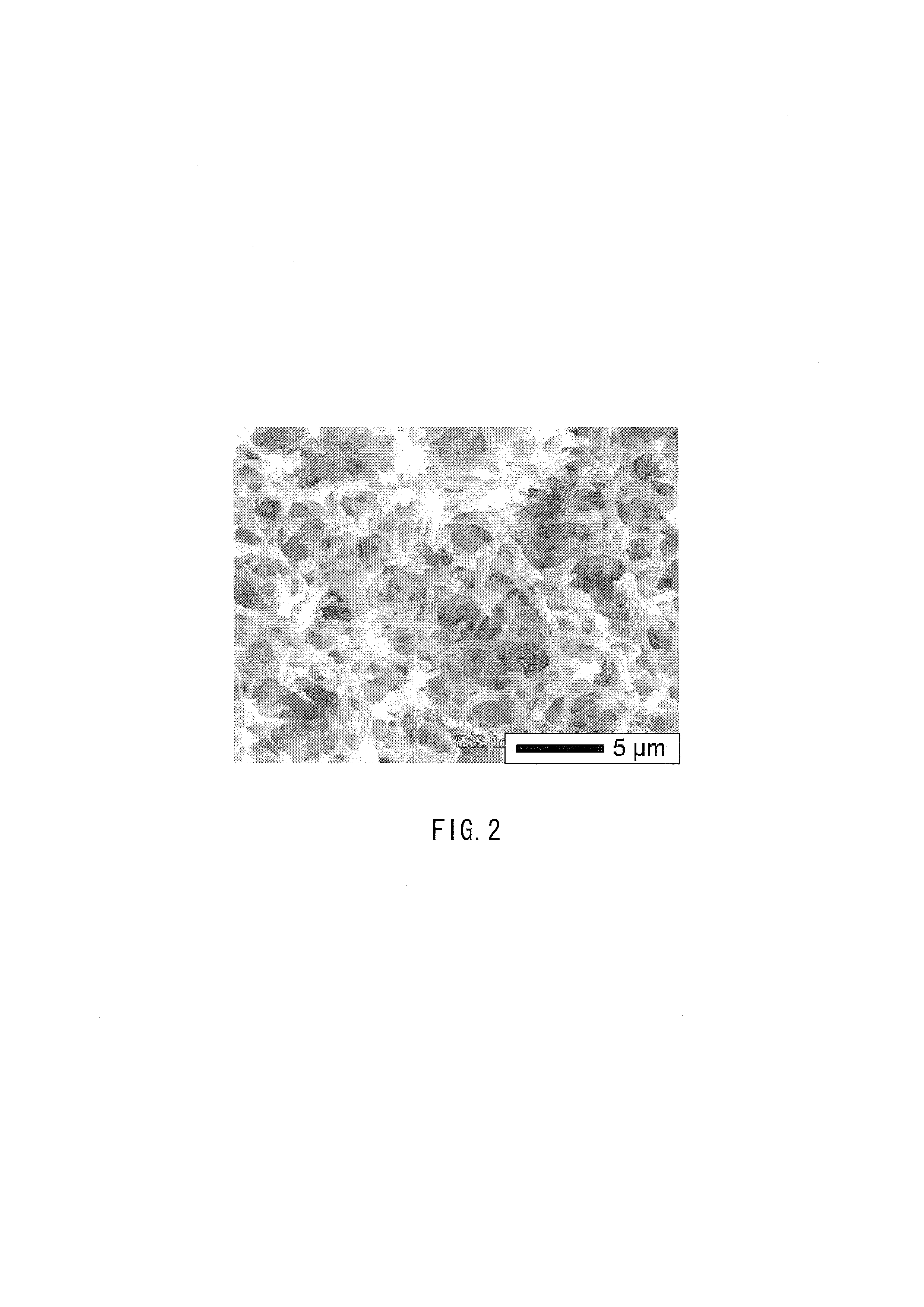Amidoxime-modified polyacrylonitrile porous body
a technology of polyacrylonitrile and amidoxime, which is applied in the direction of water/sewage treatment by ion exchange, separation with moving sorbents, nuclear engineering, etc. it can solve the problems of not being able to produce monolithic porous bodies, not yet in practical use as separating materials, and not being able to use the obtained porous bodies as metal adsorbents, etc., to achieve high metal adsorption capability and certain thickness
- Summary
- Abstract
- Description
- Claims
- Application Information
AI Technical Summary
Benefits of technology
Problems solved by technology
Method used
Image
Examples
example 1
(1) Production of Monolithic PAN Porous Body A (Starting Material) with Thickness of 1 mm or More
[0059]PAN (average molecular weight Mw=150,000) was added to a DMSO / H2O (88 / 12 vol %) mixed solvent (first solvent) in a concentration of 100 g / ml and stirred at 75° C. After complete dissolution, the stirring bar was removed and the mixture was left to stand still in a water bath at 0° C. for 60 minutes. Phase separation occurred after cooling, thus giving a product having the shape of a sample tube (cylindrical shape) (see FIG. 1). This product was immersed in methanol (different solvent, second solvent) and shaken in a bioshaker at 20° C. for 24 hours. Methanol (second solvent) was changed 3 times in 24 hours to replace DMSO and water of the solvent (first solvent) with methanol (second solvent). Thereafter, reduced pressure drying was carried out at room temperature for 4 hours to remove methanol (second solvent), thus giving a PAN porous body A(dimensions: a substantially cylindrica...
example 2
[0075]A PAN-oxime porous body was obtained in the same manner as in Example 1 except that a methanol solution of 1.2 M hydroxylamine (3 equivalents in relation to the nitrile group in the PAN porous body A) was used in place of the methanol solution of 0.40 M hydroxylamine and the reaction time was changed from 4 hours to 6 hours. The mass of the obtained PAN-oxime porous body increased by 49.5%, the introduction rate of amidoxime group was 10.03 mmol / (g of porous body), the specific surface area obtained by the BET method was 95 m2 / g, and (B) / (A) of the obtained PAN-oxime porous body was 194.
example 3
[0076]A PAN-oxime porous body was obtained in the same manner as in Example 1 except that a methanol solution of 0.1 M hydroxylamine (0.25 equivalents in relation to the nitrile group in the PAN porous body A) was used in place of the methanol solution of 0.40 M hydroxylamine and the reaction time was changed from 4 hours to 6 hours. The mass of the obtained PAN-oxime porous body increased by 13.3%, the introduction rate of amidoxime group was 3.51 mmol / (g of porous body), the specific surface area obtained by the BET method was 190 m2 / g, and (B) / (A) of the obtained PAN-oxime porous body was 2.0.
TABLE 1reaction conditionsConcentration ofEquivalents in relation tohydroxylamine innitrile group in PANReaction timemethanol solutionporous body A(hour)Example 10.4M1 equivalent4Example 21.2M3 equivalents6Example 30.1M0.25 equivalents 6obtained productsElement ratioIntroductionIncreaseof nitrogen inrate of amidoxime groupin massamidoximized(mmol / (%)porous body(g of porous body))(B) / (A)Exam...
PUM
| Property | Measurement | Unit |
|---|---|---|
| Thickness | aaaaa | aaaaa |
| Length | aaaaa | aaaaa |
| Length | aaaaa | aaaaa |
Abstract
Description
Claims
Application Information
 Login to View More
Login to View More - R&D
- Intellectual Property
- Life Sciences
- Materials
- Tech Scout
- Unparalleled Data Quality
- Higher Quality Content
- 60% Fewer Hallucinations
Browse by: Latest US Patents, China's latest patents, Technical Efficacy Thesaurus, Application Domain, Technology Topic, Popular Technical Reports.
© 2025 PatSnap. All rights reserved.Legal|Privacy policy|Modern Slavery Act Transparency Statement|Sitemap|About US| Contact US: help@patsnap.com



